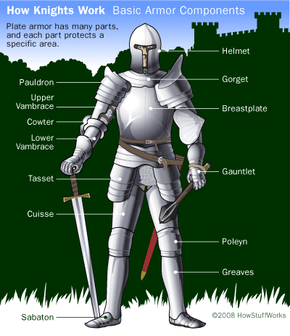Armor and Weapons
Throughout the Middle Ages, the armor used by knights varied. Knights in the early Middle Ages, using technology from the Romans, wore leather armor. Leather was very expensive, but it could be easily shaped and hardened by boiling in water or oil. It was effective in stopping sword cuts but was vulnerable to thrusts and arrows.
Throughout the Middle Ages, knights wore chain mail (again, technology borrowed from the Romans). Chain mail consisted of small, interwoven steel rings. The ends of the rings could be close to one another (butted mail) or affixed with a metal rivet (riveted mail). Chain mail was relatively easy to make, cheaper than later forms of armor and relatively effective in stopping a slice from a weapon. However, it was vulnerable to pointed weapons.
Advertisement
As blacksmiths and armorers improved their metalworking skills, they developed plate armor in the latter half of the Middle Ages. The plates provided protection and ease of movement (knights wore chain mail underneath to protect open areas called gussets (in underarms and at joints). Each plate covered a different area and had a specific name, as shown in the drawing. Plate armor was effective against cuts and thrusts, but it was expensive. Also, contrary to popular belief, armored knights could move in plate armor -- they could mount and dismount from a horse and get up if knocked down. But eventually, when firearms came into use, plate armor became ineffective.
Knights do exist today, even though they don't wear chain mail or fight on horseback. So what do they do -- and what does someone have to do nowadays to become one? Find out on the next page.
